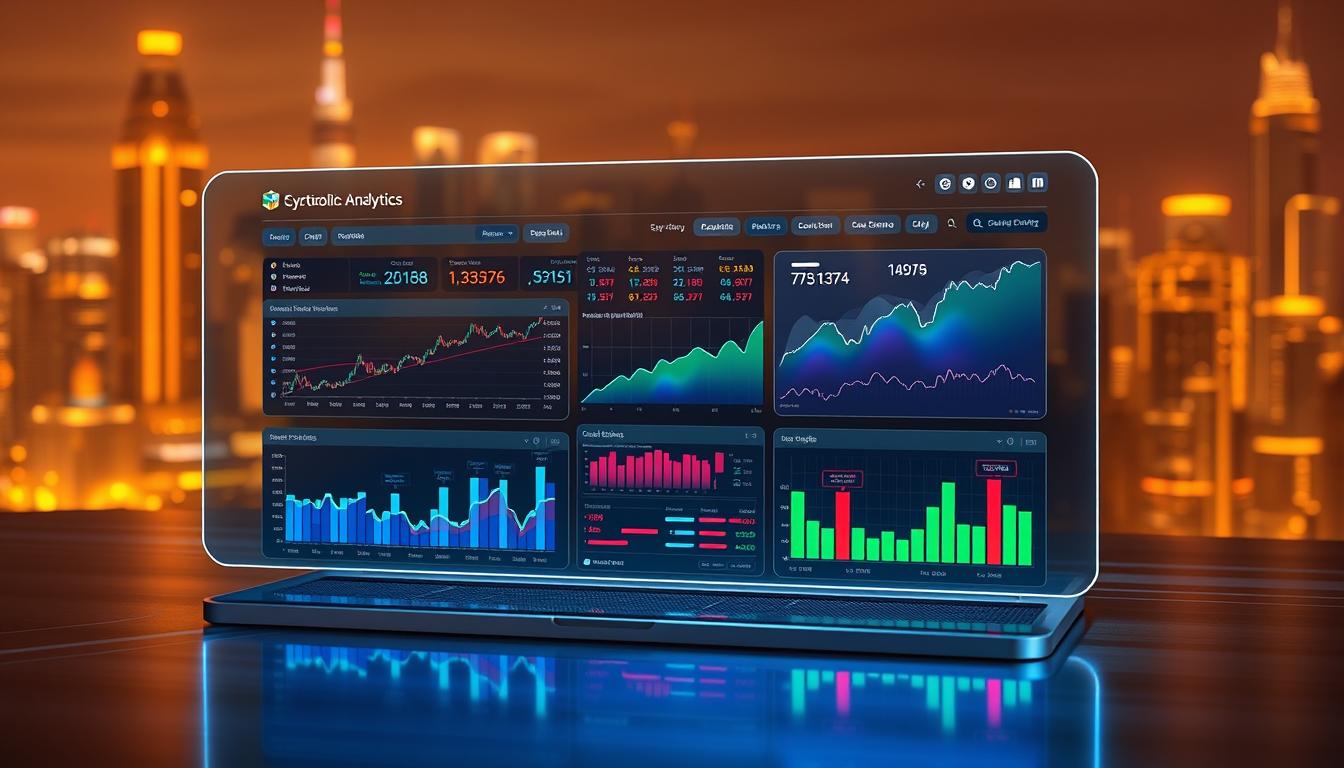Now Reading: Unlock the Power of On-chain Analytics: A Comprehensive Guide
- 01
Unlock the Power of On-chain Analytics: A Comprehensive Guide
Unlock the Power of On-chain Analytics: A Comprehensive Guide

Blockchain technology has reshaped how traders interact with financial markets. Unlike traditional systems, networks like Bitcoin and Ethereum operate on public ledgers, offering full visibility into every transaction. This transparency turns raw blockchain data into a goldmine for those who know how to interpret it.

For traders, this means accessing the same information institutions use to make decisions. You can track wallet activity, monitor token flows, and spot trends before they impact prices. Platforms like Solana and Ethereum provide real-time updates, letting you see market shifts as they happen.
Traditional analysis often relies on historical price charts or speculation. Blockchain analysis, however, focuses on actual network behavior. By studying metrics like exchange inflows or large holder movements, you gain actionable insights rooted in verifiable activity.
This approach creates a level playing field. Whether you’re tracking “whales” or assessing network health, the data doesn’t lie. It’s a game-changer for crypto strategies, replacing guesswork with evidence-based decisions.
Key Takeaways
- Blockchains like Bitcoin and Ethereum provide transparent, real-time transaction records
- Traders can access institutional-grade data to spot emerging trends
- Network activity analysis offers clearer signals than price charts alone
- Monitoring large wallet movements helps anticipate market shifts
- Real-time metrics enable faster, more informed trading decisions
Understanding the Fundamentals of Blockchain Data
At the core of every blockchain lies a revolutionary approach to data management. Unlike traditional databases, these systems record every transaction across thousands of computers simultaneously. This creates a permanent, tamper-proof history visible to all participants.

What is On-chain Data and How is it Recorded?
On-chain data refers to verified activities permanently stored on distributed ledgers. When users send crypto assets, the network records sender/receiver addresses, timestamps, and amounts. Miners or validators confirm these details through consensus mechanisms like Proof of Work before adding them to blocks.
Major networks like Bitcoin and Ethereum update their ledgers every 10-15 seconds. This process creates an unbroken chain of verified transactions that anyone can audit. The data remains accessible through blockchain explorers or specialized tools.
Exploring the Transparency of Public Blockchains
Public blockchains operate like open books where all entries remain visible forever. You can track a wallet’s balance changes, token movements between exchanges, or smart contract interactions in real time. This level of openness eliminates information gaps between large institutions and individual traders.
Three key features ensure reliability:
- Decentralized validation prevents single-point manipulation
- Cryptographic security locks data after confirmation
- Network-wide replication removes dependency on central authorities
This framework makes blockchain records more trustworthy than conventional financial reports. Traders can verify claims independently rather than relying on third-party statements.
Unveiling On-chain analytics: Key Metrics and Their Impact
Blockchain networks generate measurable signals that reveal market psychology and network health. Five core metrics help traders cut through noise and spot actionable trends:
Active Addresses and Transaction Volume
Active addresses show how many unique wallets send or receive assets daily. Rising numbers often hint at growing adoption – like when Bitcoin hit 1.2 million daily addresses during its 2021 bull run. Paired with transaction volume, these metrics paint a clear picture of network usage:
- Consistent growth in both = Strong organic demand
- High addresses with low volume = Possible speculative trading
- Spikes in volume = Potential institutional moves
Exchange Flows, Hash Rate, and Their Significance
When tokens flood exchanges, it often signals selling pressure. Conversely, withdrawals suggest accumulation. Bitcoin’s 2023 rally began weeks after exchanges saw record outflows. Hash rate – the computing power securing networks – acts as a health monitor. A 30% drop could indicate miner capitulation, sometimes preceding price dips.
Advanced traders combine these metrics with the NVT Ratio. Values above 90 suggest overvaluation, while readings below 40 may signal buying opportunities. This data-driven approach helps separate hype from genuine network growth.
Leveraging On-chain Analytics Tools and Platforms
The right toolkit transforms raw blockchain information into strategic advantages. Modern solutions decode complex network patterns into clear signals for traders. Let’s explore leading resources that turn data into competitive edges.

Top Platforms for Deep Blockchain Insights
Nansen leads with its 300 million labeled wallets, tracking institutional moves across chains. Its dashboards reveal NFT trends, token flows, and liquidity shifts in real time. Glassnode specializes in Bitcoin metrics, offering indicators like MVRV ratios that others miss.
Dune empowers users to build custom dashboards using SQL queries. Traders monitor DEX volumes or staking yields through community-made templates. DeFi Llama aggregates protocol health stats – from TVL surges to APY fluctuations – across 200+ networks.
Integrating Blockchain Data into Your Trading Strategy
Combine these tools like puzzle pieces. Use Nansen’s “smart money” alerts alongside Glassnode’s miner outflow charts. Cross-reference Dune’s DEX metrics with DeFi Llama’s TVL changes to spot emerging trends.
Three steps for effective integration:
- Set price alerts triggered by exchange inflows/outflows
- Track whale wallet movements during market volatility
- Compare network growth metrics against price action
Beginners should start with DeFi Llama’s visual charts before advancing to Dune’s query system. Advanced users layer multiple insights to create proprietary trading signals. Remember – consistency beats complexity in blockchain analysis.
How to Use On-chain Analysis in Trading Strategies
Smart traders blend blockchain insights with classic chart patterns to spot hidden opportunities. This fusion creates clearer signals than either method alone, helping you stay ahead in fast-moving markets.

Combining Technical Analysis with Blockchain Metrics
Pair RSI divergences with exchange outflow spikes for stronger entry signals. When Bitcoin’s price tested $30k in 2023, a surge in stablecoin deposits to exchanges hinted at impending volatility. Tools like Glassnode overlay these metrics on candlestick charts, revealing correlations between network activity and price action.
Setting Alerts and Tracking Market Trends
Platforms like Nansen send notifications when whale wallets move assets exceeding preset thresholds. Set triggers for:
- 10,000+ ETH transferred to exchanges
- Smart Money wallets accumulating specific tokens
- DEX liquidity pools doubling within hours
These alerts help catch trends before they dominate social media feeds.
Practical Steps to Implement Data-Driven Trading
Start with three actions:
- Choose two metrics matching your strategy (e.g., exchange flows + RSI)
- Build a dashboard using DeFi Llama’s templates
- Track three labeled Smart Money wallets weekly
This approach helps make informed decisions without data overload. Review your system monthly – remove outdated metrics and add emerging indicators like staking derivatives activity.
Navigating Challenges and Limitations in On-chain Analysis
While blockchain data offers unprecedented transparency, its practical use comes with significant hurdles. The sheer volume of transactions across networks like Ethereum can overwhelm even experienced investors. Market volatility adds another layer of complexity, as sudden price swings may distort the meaning of key metrics.
Filtering Signals From Noise
Effective analysis requires focusing on metrics aligned with your goals. Traders monitoring whale movements might prioritize exchange inflows over minor network upgrades. Tools like market trend dashboards help filter irrelevant data through customizable alerts.
Three critical limitations demand attention:
- Centralized exchange activities remain invisible on public ledgers
- Wallet labeling accuracy varies between platforms
- Rapid protocol changes can invalidate historical patterns
Smart investors cross-reference blockchain data with off-chain indicators like social sentiment. This dual approach reduces reliance on potentially misleading signals. Regular skill updates also prove crucial – new DeFi mechanisms emerge weekly, requiring continuous learning.
Successful traders set clear time boundaries for analysis. Spending hours tracking minor wallet movements often yields diminishing returns. Instead, focus on high-impact events like major token unlocks or protocol upgrades that drive measurable network activities.
Final Thoughts and Future Outlook on Blockchain Analytics
The evolution of blockchain technology continues to redefine financial transparency. As datasets grow and wallet labeling improves, blockchain analysis becomes more reliable. Investors now access real-time insights into asset movements, holder activities, and network health – advantages traditional markets can’t match.
Machine learning algorithms process vast datasets to spot hidden patterns. Platforms like Nansen already use these tools to predict price shifts and flag unusual wallet activities. This fusion of artificial intelligence and blockchain data creates new opportunities for making data-driven decisions.
Future advancements will likely focus on refining privacy-enhancing blockchain solutions while maintaining auditability. Investors who master these tools gain lasting advantages in tracking asset values and market trends. Staying updated with emerging networks and analysis techniques remains crucial.
Blockchain’s inherent transparency offers a permanent shift in market analysis. It empowers traders to verify activities directly rather than relying on third-party reports. As networks evolve, this approach will become essential for anyone serious about crypto investments.
FAQ
How does blockchain transparency affect data reliability?
Public blockchains like Bitcoin and Ethereum record every transaction on a decentralized ledger, accessible to anyone. This transparency ensures data authenticity, as transactions are verified by network participants and cannot be altered retroactively.
Which metrics are most critical for evaluating crypto market trends?
Active addresses, transaction volume, and exchange inflows/outflows reveal user activity and liquidity shifts. Metrics like hash rate (for Proof-of-Work networks) and staking rates (for Proof-of-Stake) also signal network health and investor sentiment.
What tools provide actionable blockchain insights?
Platforms like Glassnode, CoinMetrics, and Nansen track wallet movements, token holders, and exchange flows. Dune Analytics allows custom queries, while TradingView integrates blockchain metrics with price charts for real-time analysis.
Can blockchain data predict price movements?
While no metric guarantees price predictions, spikes in large transactions or exchange withdrawals often precede volatility. Combining these signals with technical analysis, like support/resistance levels, improves strategic decision-making.
What challenges exist in interpreting blockchain data?
Pseudonymous wallets and exchange clustering require careful interpretation. Tools like Chainalysis help map addresses to entities, but misreading whale activity or exchange reserves can lead to flawed conclusions.
How do traders set up alerts for key blockchain events?
Platforms like CryptoQuant and Santiment offer customizable alerts for metrics like sudden exchange inflows, whale transactions, or network congestion. These triggers help traders react faster to market-moving events.
Why do exchange flows matter in market analysis?
Rising exchange deposits often indicate selling pressure, while withdrawals suggest accumulation. Monitoring platforms like Binance or Coinbase Pro balances helps gauge short-term sentiment shifts among retail and institutional players.















